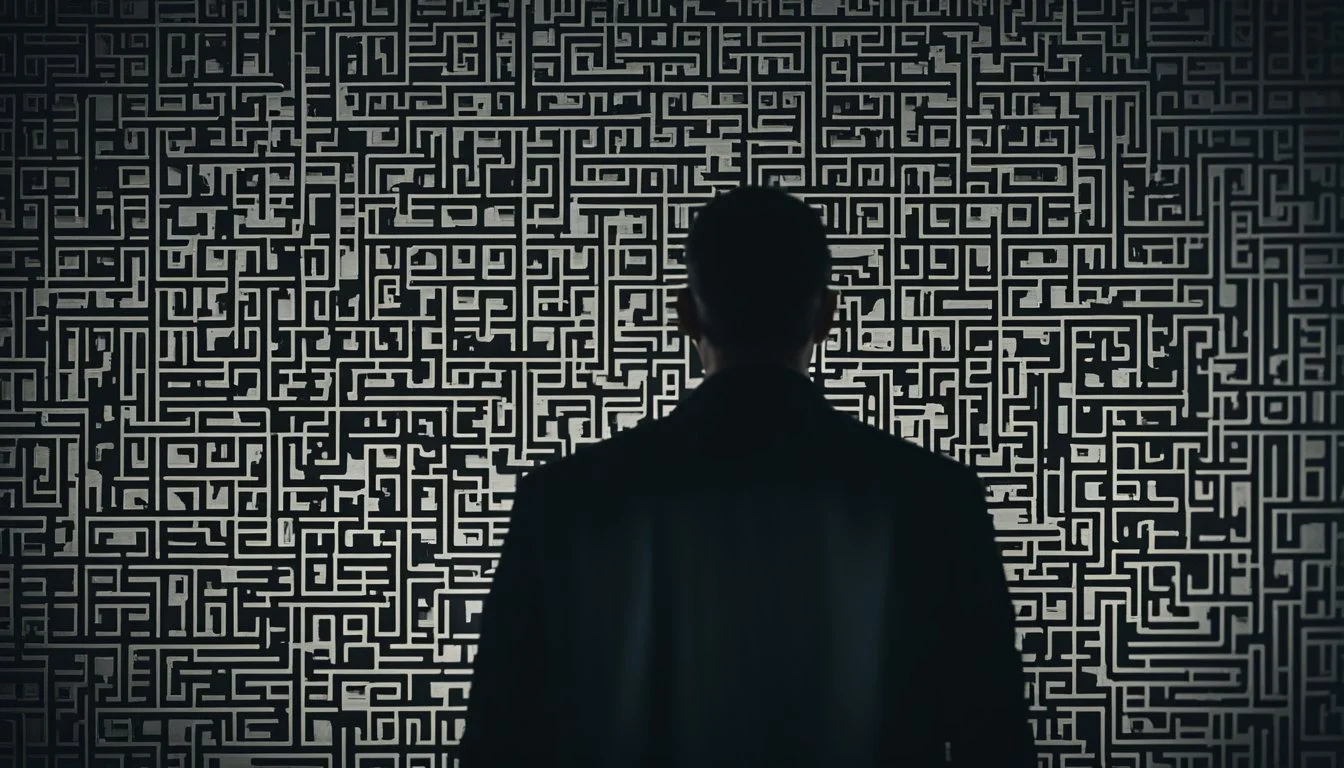8 Films That Challenge Our Understanding of Paranoid Behavior
A Deep Dive into Cinematic Psychology
Paranoia can manifest in various ways, often rooted in fear and distrust that push individuals to question their perception of reality. Films exploring paranoid behavior provide audiences with a unique perspective on how fear and uncertainty can drive people to make irrational decisions.
By examining these narratives, viewers gain insight into the complexities of paranoia and its impact on human behavior. These films provoke reflection on the influences that shape our thoughts and actions, revealing the often tenuous line between perception and reality.
1) A Beautiful Mind (2001)
"A Beautiful Mind" explores the life of John Nash, a brilliant mathematician who grapples with schizophrenia. The film portrays Nash's development of paranoid behavior alongside his academic achievements. It highlights the challenges he faces in distinguishing between reality and delusion.
The movie is based on the true story of Nash, who won the Nobel Prize in Economics for his work in game theory. His experiences with paranoia are depicted through his interactions with imagined individuals. This portrayal offers insight into the complex relationship between genius and mental illness.
Set in the mid-20th century, the film details Nash's time at Princeton and his subsequent career. His journey showcases both his intellectual triumphs and personal struggles. The narrative provides a nuanced depiction of how paranoia impacts one's professional and personal life.
By portraying Nash's battle with schizophrenia, "A Beautiful Mind" sheds light on the broader societal implications of mental health. It emphasizes the importance of support and resilience in overcoming life's challenges. The film effectively illustrates how mental illness can shape a person's experience and perception of the world.
For more information on "A Beautiful Mind," visit IMDb.
2) The Conversation (1974)
"The Conversation," directed by Francis Ford Coppola, stands as a pivotal work in the paranoid thriller genre. Released in 1974, the film delves into the life of Harry Caul, a surveillance expert portrayed by Gene Hackman. Caul becomes increasingly distraught by a recording he has captured, reflective of rising concerns about surveillance.
Coppola's mastery in creating suspense is evident as he explores themes of privacy invasion and moral ambiguity. The film's sound design, led by Walter Murch, effectively heightens tension by manipulating what the audience hears, mirroring Caul’s deteriorating mental state as he questions the impact of his work.
A hallmark of 1970s cinema, the film responds to the era's growing unease with technology and surveillance. It embodies the period's spirit of skepticism and illustrates the psychological toll on individuals ensnared in the web of espionage.
For more insights on "The Conversation," one can explore its detailed presentation on Wikipedia or the film's profile on IMDb.
3) Prisoners (2013)
Denis Villeneuve's film "Prisoners" explores the nature of fear and morality within a gripping thriller framework. The movie, set in a small town, tells the story of two families whose daughters have vanished, provoking a frantic search that uncovers community secrets.
The film delves into the psychological impact of extreme situations. As the characters grapple with their fears, decisions driven by paranoia blur the lines between good and evil. This creates a tense, unsettling atmosphere that keeps viewers guessing about each character's true intentions.
Villeneuve's choice of Roger Deakins as cinematographer enhances the film's atmospheric tension. Lighting and shadows play a crucial role in depicting the characters' inner turmoil. This visual storytelling complements its exploration of ethical dilemmas and survival instincts.
The narrative leaves audiences questioning the morality of actions taken in desperation. Viewers are invited to reflect on enduring moral questions, making "Prisoners" a profound exploration of human behavior under pressure.
For more information, visit the Wikipedia page or IMDB page.
4) Donnie Darko (2001)
Donnie Darko, a 2001 psychological science fiction film, delves into the complex interplay of reality, time, and mental health. The plot follows a troubled teenager, Donnie, who experiences unsettling visions and interactions with a mysterious figure in a rabbit suit.
The film explores themes of paranoid schizophrenia, depicting its effects on Donnie's perception of the world around him. His visions often blur the line between reality and hallucination, illustrating the challenges faced by those with similar conditions. The narrative creates an atmosphere of tension and uncertainty that leaves viewers questioning what is real.
Donnie Darko also reflects on the societal perception of mental illness, presenting a nuanced portrayal that differs from typical media representations. By integrating elements of suspense and mystery, it presents an engaging narrative while encouraging reflection on mental health issues.
The film has garnered critical acclaim and a cult following, celebrated for its unique storytelling and memorable performances. It challenges viewers to consider the intersection of mental health and reality through a layered and thought-provoking narrative.
For further details, visit Wikipedia or IMDb.
5) The Machinist (2004)
"The Machinist," directed by Brad Anderson, is a psychological thriller exploring the depths of paranoia. Christian Bale delivers an intense performance as Trevor Reznik, an industrial worker battling severe insomnia and paranoia. Over time, his lack of sleep amplifies his delusions, blurring the line between reality and hallucination.
Trevor's descent into madness is marked by his skeletal appearance and erratic behavior. Through its narrative, the film masterfully depicts how paranoia can erode mental health, leading to self-destructive paths. It excels in creating a gripping atmosphere, keeping the audience on edge as they witness Trevor's unraveling.
This film received considerable attention for its portrayal of mental deterioration and is recognized for challenging perceptions of paranoid behavior. As Trevor's paranoia intensifies, viewers are left questioning what is real and what is imagined, offering an introspective look into the human psyche.
For more information, visit The Machinist on IMDB.
6) Enemy (2013)
Enemy, directed by Denis Villeneuve, is a psychological thriller that invites viewers into a world of doubles and paranoia.
Jake Gyllenhaal stars as both Adam Bell, a mild-mannered college professor, and Anthony Claire, a brash actor who looks identical to him. This eerie resemblance fuels a sense of unease as Adam becomes obsessed with tracking Anthony down, leading to a series of unsettling encounters.
Villeneuve's film explores themes of identity and duplicity, adding layers of ambiguity that arouse suspicion and doubt. The strained relationships and cryptic events heighten the tension, challenging viewers to question what is real.
Visually, the film uses muted colors and shadows to create an atmosphere of oppression and mystery, enhancing the feeling of paranoia as Adam navigates a world that seems increasingly unfamiliar.
This complex narrative intertwines with symbolic imagery, weaving a rich tapestry of suspense and existential dread. The film remains open to interpretation, encouraging critical analysis of its deeper meanings related to personal and psychological fractures.
For more on this intriguing film, visit Enemy on IMDb.
7) Shutter Island (2010)
"Shutter Island" is a psychological thriller directed by Martin Scorsese. It examines the complexity of the human mind through its portrayal of paranoid delusions and mental instability.
Set in the 1950s, the film follows U.S. Marshal Teddy Daniels, played by Leonardo DiCaprio. He travels to Ashecliffe Hospital for the criminally insane, located on a remote island.
As the story unfolds, viewers experience the blurred lines between reality and delusion. The film's atmosphere, intense plot twists, and mysterious setting make it a compelling exploration of paranoia and psychological disorders.
Through its narrative, "Shutter Island" challenges audiences to question perception and the nature of truth. These elements contribute to its enduring appeal.
8) Mulholland Drive (2001)
David Lynch's Mulholland Drive is a mesmerizing exploration of paranoia and identity in the glamorous yet sinister backdrop of Los Angeles. This film follows the story of Diane, a young woman whose aspirations in the city take a darker turn.
The film artfully blurs the line between reality and fantasy, creating an atmosphere rife with tension and ambiguity. A central element of the narrative involves a mysterious blue box and key, which serves as a pivotal symbol of hidden truths and forgotten memories.
Viewers are drawn into a complex web of intrigue as characters grapple with their own perceptions and unfulfilled desires. Naomi Watts delivers a compelling performance, capturing the dissonance between the world of dreams and the starkness of reality.
Lynch's storytelling challenges the audience to piece together fragmented narratives, making Mulholland Drive a film that continues to inspire analysis and debate. Its unique approach to themes of paranoia and disintegration of identity cements its status as a classic of surreal cinema.
For more information on the film, visit IMDB.
Understanding Paranoid Behavior
Paranoid behavior involves complex psychological and societal factors. These encompass a range of cognitive and emotional processes, along with societal dynamics that can influence perceptions and interactions.
Psychological Foundations
Cognition and Emotion: Paranoid behavior often begins with cognitive distortions. Individuals may interpret events inaccurately, viewing neutral situations as threatening. This is typically accompanied by heightened emotional responses, like anxiety or fear, which amplify the perception of threats.
Biological Influences: Neurobiological factors, such as brain chemistry imbalances, can predispose individuals to paranoia. For example, neurotransmitter disruptions may alter mood regulation, making individuals more prone to suspecting others.
Societal Influences
Cultural Impact: Cultural beliefs and media can shape perceptions, as exposure to conspiracy theories or mistrustful narratives can reinforce paranoid thoughts. Certain societal conditions, such as widespread uncertainty, can also heighten distrust.
Interpersonal Relationships: Within social contexts, experiences of betrayal or repeated negative social interactions can fuel paranoia. Relationships built on distrust or abuse can exacerbate the tendency to assume hostile intentions in others. Such experiences often contribute to a cycle of suspicion and alienation.
In-Depth Look At Cinema's Portrayal Of Paranoia
Cinema has used paranoia as a powerful storytelling tool, often revealing the multifaceted nature of fear and suspicion. Filmmakers employ narrative techniques and nuanced character development to explore these themes.
Narrative Techniques
Filmmakers utilize a variety of techniques to depict paranoia effectively on screen. Visual style is crucial, with directors frequently using unconventional camera angles and lighting to create a sense of unease. The Matrix and The Truman Show are prime examples where reality seems distorted, fostering a sense of distrust in the viewer.
Story structure also plays a key role. Non-linear timelines and unreliable narrators become vehicles to unsettle the audience, blurring the line between reality and imagination. Such techniques invite viewers to question the truth, enhancing the film's paranoid atmosphere.
Character Development
Character development in films about paranoia often focuses on isolation and mistrust. Characters like those in The Thing or Coppola’s thrillers are frequently portrayed in settings that cut them off from the outside world, intensifying their feelings of suspicion and fear.
Screenwriters delve deep into the psychological profiles of these characters, revealing traits that amplify their paranoia. In doing so, they provide insight into how paranoia affects human behavior, decision-making, and interactions. This approach allows the audience to engage with the characters’ internal battles, offering a window into the human psyche under the strain of paranoia.








